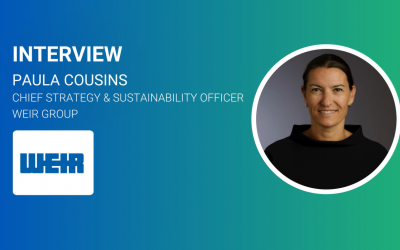Megha Lakhchaura on the investment potential of transportation electrification
Climate Action followed up with Megha Lakhchaura, director policy and utility programs at EVBox, to discuss the benefits of investing in EVs and EV charging infrastructure.

In EVBox’s Climate Leader discussion at the conference, your colleagues sounded quite enthusiastic about the emerging market for electric vehicles and EV charging. Why should we share your enthusiasm?
As humans, we’re naturally skeptical about the prospects for wholesale change from the norms we’ve grown accustomed to. I get that. And, coming from EVBox, I suppose you could say we’re a bit biased. That aside, you don’t have to take our word for the coming change. You can see the signs everywhere.
On the investment side, look no further than the ESG movement. As we noted at the conference, when the head of the world’s largest asset manager tells corporate leaders that they must adopt a sustainable growth model and move away from the risks inherent in fossil fuels, you realize that the shift is already happening and is moving into the mainstream.
On the American market side, look at the automakers. GM has taken a leadership role here, with its intention to eliminate all tailpipe emissions from passenger cars by 2035. The world’s largest vehicle manufacturers are following suit. New model announcements and new commitments happen almost daily.
States like California have banned the sales of internal combustion engines post 2035. Both national and state policies are promoting widespread EV adoption through incentives, tax credits, and even mandates. California also mandated that 90 percent of the miles driven by ride-hailing companies in California must be in electric vehicles— forcing Uber and Lyft to make a quicker transition to EVs.
And consumers are beginning to embrace the shift. Sales of EVs are surging worldwide.
With new international commitments, we hope, coming out of COP26, more policy support for EVs, new national and local regulations aimed at curbing greenhouse gases, greater purchasing incentives, an expanding array of consumer choices, and the coming cost parity of EVs with gas-powered cars, the momentum is growing. The shift to EVs is inevitable and inexorable.
Beyond the automakers themselves, who can invest in the EV transition?
When it comes to investing, you always want to be ahead of the curve. That’s why we see the present as the best time to invest. We’re really on the ground floor of the EV transformation. So there’s still a first-mover advantage for many players. It’s a historic opportunity that shouldn’t be missed.
In terms of EV charging infrastructure, two of the biggest markets are fleets and consumer companies.
If you’re a fleet owner, you’re looking at an enormous opportunity to reduce your carbon footprint and fuel costs. And especially as the initial cost of EVs falls, the reduction in ongoing operational and maintenance expenses can be a significant motivation to electrify the fleet. Additionally, several state incentives for both vehicles and chargers can reduce the upfront capital costs significantly.
Aside from fleets, electrification also makes sense for companies that serve consumers like retail, hotels, and so on. We see this as a competitive advantage. If a business provides EV charging ports at their locations, they can establish themselves as the preferred location for EV drivers and gain an edge over their competition. Customers prefer locations with charging ports, and they’ll stay there longer as their cars refuel. And the business can earn additional revenue from charging.
Making money while doing good—now that’s a winning proposition for all.
Let’s drill down into the fleet market a bit more. Where are the opportunities there?
It’s a huge market. In the United States alone, there are more than 8 million fleet vehicles. A short list would include government agencies, first responders, military organizations, utility companies, trucking companies, rental fleets, and ride-hailing providers.
One obvious example of electrification opportunities is with delivery vehicles. Trucks and vans from the likes of Amazon, UPS, and FedEx have become ubiquitous in our neighborhoods, and they have all announced fleet electrification targets. Those companies spend a lot of money on fuel and maintenance. So the prospect of significantly reducing those costs is very attractive. This is already part of their plans: Amazon has announced its intention to buy 100,000 Rivian electric vehicles for its fleet, while Fedex plans to go fully electric by 2040.
You’ve talked about the advantages of going electric to include the reduction in carbon emissions and the lower costs of fuel and maintenance. In your discussions with potential customers, do you talk about other benefits?
Very much so. In addition to those carbon and cost reductions, we see at least six other advantages. First, as we’ve said, the advantage goes to the quick: The first to adopt electrification will be the first to reap its rewards—earlier returns on investment. Second, it’s a timing advantage: By the time their competitors are still in the early stages of the transition, they will already be moving into scaling and optimizing their operations. Third, it’s a risk-reduction strategy: They’ll be ahead of the curve on meeting emissions regulations.
Fourth—and another risk-reducer—they’ll be lowering their risks of having to write off stranded assets in the form of internal combustion vehicles without a viable future. Fifth, it’s a competitive advantage: They’ll attract and retain EV-driving employees and customers. Lastly, it’s a reputational advantage: They’ll burnish their sustainability bona-fides by being seen as a leader in the transition to a net-zero economy. And don’t forget that we’ve also talked about the potential for gaining a new revenue stream from charging fees.
In your colleague’s presentation, he referenced research from BloombergNEF stating that to reach net zero by mid-century will require nearly three-quarters of a billion EV charging connections. Considering that we’re only at about 1 million charging ports globally now, we have a long way to go. Any thoughts on how we’ll get there?
That’s a great question. It’s absolutely necessary to have a goal to stretch for. It’s another thing to execute on that goal, as you know. The best way to get there is through open standards, government investment, and interoperability.
You also have to look at things from the perspective of the owner of the charging equipment. You don’t want to invest in a technology that becomes obsolete or outmoded and run the risk of being stuck with a stranded asset. With open standards, you can invest with confidence in hardware knowing that you can keep it updated or change out the software if you want. Charging station owners need and deserve greater choice, flexibility, and certainty in the equipment they buy.
Also, interoperability between networks is a critical piece to provide EV drivers with access to different networks. If you’re an EV driver, you want a seamless charging experience. You want charging that is simple, accessible, and universal.
Another crucial element is government investment in charging infrastructure. This can be in the form of rebates, grants, and tax credits.
Any closing thoughts?
It can be daunting to think about what needs to be done to transform our economies away from fossil fuels. But what an exciting time we live in! Yes, the challenges are great. But so too are the opportunities and the rewards. It’s not every day that we have the chance to radically alter the way we get around, the way we power our homes and businesses, and the way we produce our materials.
In terms of transport, we’re on the verge of a massive transformation in our mobility system. This will bring tremendous benefits to society—including trillions of dollars saved, sharply reduced greenhouse gas emissions, and greater mobility for everyone. And it has to scale fast. Both from a business, professional and personal perspective, it’s exhilarating to play a part in this revolution.
EVBox are speaking at the Sustainable Innovation Forum 2021, to join them register here now.






